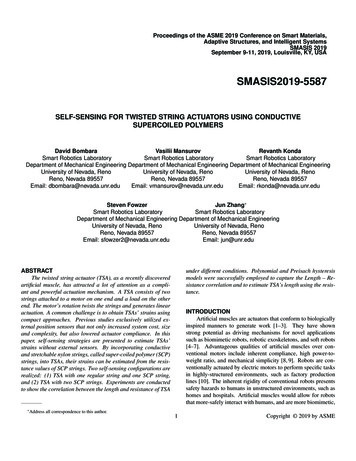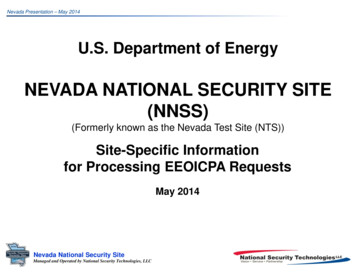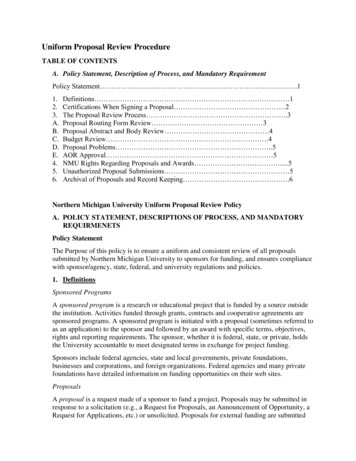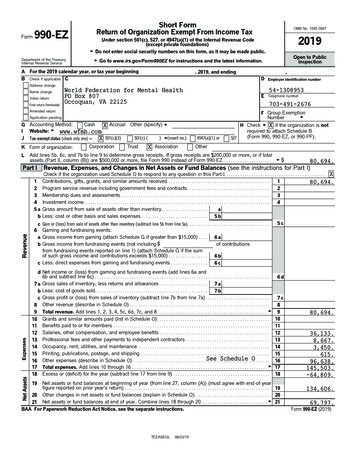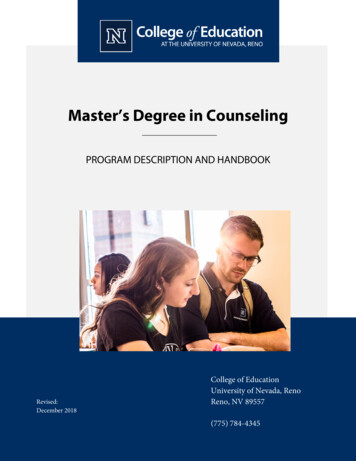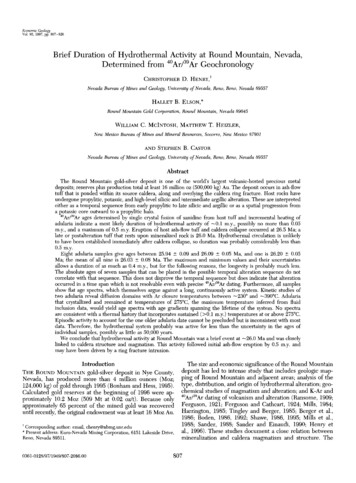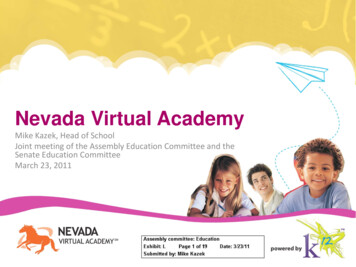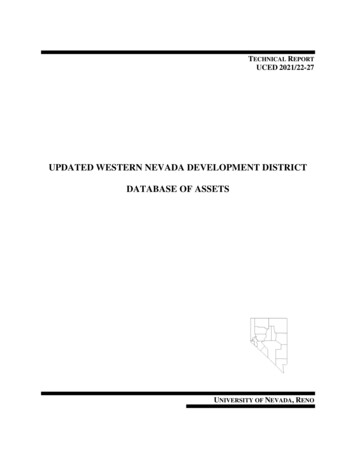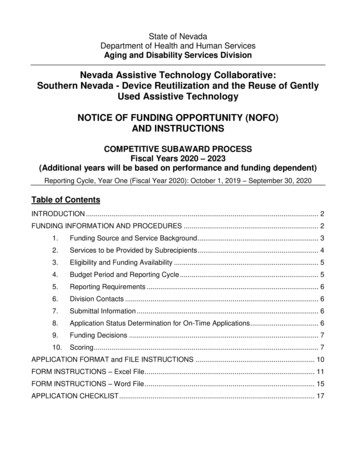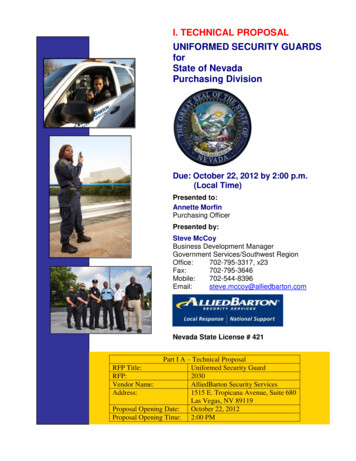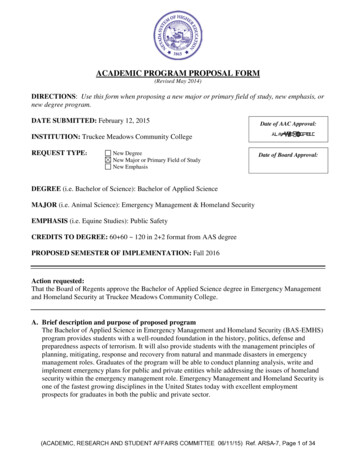
Transcription
ACADEMIC PROGRAM PROPOSAL FORM(Revised May 2014)DIRECTIONS: Use this form when proposing a new major or primary field of study, new emphasis, ornew degree program.DATE SUBMITTED: February 12, 2015INSTITUTION: Truckee Meadows Community CollegeREQUEST TYPE:New DegreeNew Major or Primary Field of StudyNew EmphasisDate of AAC Approval: SULO Date of Board Approval:DEGREE (i.e. Bachelor of Science): Bachelor of Applied ScienceMAJOR (i.e. Animal Science): Emergency Management & Homeland SecurityEMPHASIS (i.e. Equine Studies): Public SafetyCREDITS TO DEGREE: 60 60 120 in 2 2 format from AAS degreePROPOSED SEMESTER OF IMPLEMENTATION: Fall 2016Action requested:That the Board of Regents approve the Bachelor of Applied Science degree in Emergency Managementand Homeland Security at Truckee Meadows Community College.A. Brief description and purpose of proposed programThe Bachelor of Applied Science in Emergency Management and Homeland Security (BAS-EMHS)program provides students with a well-rounded foundation in the history, politics, defense andpreparedness aspects of terrorism. It will also provide students with the management principles ofplanning, mitigating, response and recovery from natural and manmade disasters in emergencymanagement roles. Graduates of the program will be able to conduct planning analysis, write andimplement emergency plans for public and private entities while addressing the issues of homelandsecurity within the emergency management role. Emergency Management and Homeland Security isone of the fastest growing disciplines in the United States today with excellent employmentprospects for graduates in both the public and private sector.(ACADEMIC, RESEARCH AND STUDENT AFFAIRS COMMITTEE 06/11/15) Ref. ARSA-7, Page 1 of 34
B. Statement of degree or program objectivesIdentify the underlying principles and roles of Emergency Management and Homeland Securitywithin public organizations and private sector business. Apply the concepts of the professional skillsand competencies in Emergency Management and Homeland Security planning, mitigation, responseand recovery.C. Plan for assessment of degree or program objectivesAdvisory Board review of student portfolio/presentation of their work product according to astandard rubric, and assessment from EM 416 and/or HS 416 internship courses and assessmentfrom EMHS 490, Capstone course.D. Plan for assessment of student learning outcomes and the use of this data for programimprovementThis data will be evaluated against standard competencies and their achievement based uponnationally accepted standards of the industry. This data will be evaluated by program staff and theadvisory committee that primarily consists of practitioners in the field of Emergency Managementand Homeland Security. Revisions and improvements will be implemented upon recommendation ofboth.E. Contribution and relationship of program objectives toi. NSHE Master PlanThe BAS in Emergency Management and Homeland Security supports The State & the System:NSHE Plan for Nevada's Colleges and Universities by promoting more entry-level graduatestowards the state becoming "competitive and more economically prosperous" and by moreclosely adhering to NSHE's credit standards of 120 credits for a Bachelors level degree. Inaddition, it supports the needs of government, business and industry in Nevada in the modern eraof continuity of operations and the states and private industries ability to plan for, mitigate,respond to and recover from natural and man-made disasters.ii. Institutional missionThe BAS in Emergency Management and Homeland Security is aligned with the College'smission of "promoting student success, academic excellence and access to lifelong learning bysuppoting high-quality education and services within our diverse community." By providing aneducational opportunity that leads to needed entry-level positions in our community. It furtherextends the opportunities for students who have earned the AAS degree in PrehospitalEmergency Medicine or Fire Technology to further their education in emergency services to theBachelor degree level.iii. Campus strategic plan and/or academic master planThe BAS in Emergency Management and Homeland Security is aligned with the College'sStrategic Master Plan, Core Theme II, Academic Excellence, Objective 3: Meet workforceeducational needs in the service area as well as Core Theme III, Objective 3: Create, expand,and/or strengthen partnerships with civic, community, educational, and business/industryorganizastions to provide lifelong learning opportunities.iv. Department and college planThe BAS in Emergency Management and Homeland Security reflects the Division of TechnicalScience's principles of providing high quality training that is responsive to the needs of studentsand employers, as well as Emergency Services mission to "improve the quality of life and health(ACADEMIC, RESEARCH AND STUDENT AFFAIRS COMMITTEE 06/11/15) Ref. ARSA-7, Page 2 of 34
in our community by professionally preparing students for entry-level employment and careeradvancement in emergency planning, mitigating, response and recovery by providing highquality, innovative training based on national standards."v. Other programs in the institutionvi. Other related programs in the SystemThe College of Southern Nevada has an Associate Degree in Emergency ManagementAdministration and UNLV has a Masters degree in Crisis and Emergency Management. TheBAS degree at TMCC will provide CSN students seeking a Bachelors degree to transfer in-stateand retain in-state fees. The TMCC BAS degree will likely become a feeder program for theMasters degree at UNLV.F. Evaluation of need for the programi. Intrinsic academic value of program within the disciplineThe discipline of Emergency Management and Homeland Security have become a rapidlyemerging profession in the post-9/11 world. The demand for these professionals in both thepublic and private sector will continue to grow over the foreseeable future.See Appendix - A Consultant Reportii. Evidence of existing or projected local, state, regional, national and/or international needfor programA 2010 US News and World Reports article cited Emergency Management as one of the 50 bestjobs of 2011. The article cited a 2008-2018 Bureau of Labor Statistics employment growth of22%. Later Bureau of Labor statistics projections from 2014 show a more modest growth in thisfield of 8% or as fast as the average growth for all career fields between 2012 and 2022.See Appendix - A Consultant Reportiii. If this or a similar program already exists within the System, what is the justification forthis additionCurrently within the NSHE, there is an Associate level degree and Masters level degree, but noBachelors degree.iv. Evidence of employment opportunities for graduates (state and national)In a broad search on the International Association of Emergency Managers website, jobs boardas of 2/12/15 there are 206 jobs in the Emergency Management discipline available on a nationallevel. Within the state of Nevada there are approximately 60 identified Emergency Managers instate, local and tribal governments. In discussion with the Chief of Nevada's Division ofEmergency Management, there are likely 1000's of jobs in Nevada alone where EmergencyManagement is a substantial part of or identified as a collateral duty within public and privateemployment job descriptions.v. Student clientele to be served (Explain how the student clientele is identified)It is anticipated this degree will attract students from military, law enforcement, fire, EMS,community and public health, and nursing disciplines as the discipline continues to broadenacross the regions professional landscape.(ACADEMIC, RESEARCH AND STUDENT AFFAIRS COMMITTEE 06/11/15) Ref. ARSA-7, Page 3 of 34
G. Detailed curriculum proposali. Representative course of study by year (options, courses to be used with/withoutmodification; new courses to be developed)The fire technology and pre-hospital emergency medicine associate of applied science degreeswill generate the first two years of the BAS degree currently with other potential AAS degrees inthe future.1st fall semester of BAS program:* GEOL-100 Earthquakes, Volcanoes and Natural Disasters (additional Gen Ed)*PSC-101 Introduction to American Politics (additional Gen Ed)*EM-300 Principles, Practice, Philosophy & Doctrine of EM (Degree)*EM-301 Principles and Practice of Hazard Mitigation (Degree)*EM-302 Holistic Disaster Recovery (Degree)1st spring semester of BAS program: (15 credits total in semester)*EM-303 Hazard Risk Management (Degree)*EM-304 National Incident Management System (only if entering with EMS AAS)*EM-404 Business Crisis Continuity Management (Degree)*EM-406 EM Budget and Administration (Degree)*EM-407 EM Management and Leadership Communication (only if entering with EMS AAS)*HS-300 Terrorism (Degree)*HS-301 HS: Preparedness, Prevention and Deterrence (Degree)2nd fall semester of BAS program: (15 credits total in semester)*HS-302 Critical Thinking for Homeland Security (Degree)*HS-303 Terrorism and Homeland Security in the US (Degree)*HS-402 Protecting the Homeland: Balancing Security & Liberty (Degree)*HS-403 Critical Infrastructure and Resource Protection (Degree)*One Elective from EM/HS elective list*HS-300 Terrorism (only if entering with EMS AAS)*HS-301 HS: Prepareness, Prevention and Deterrence (only if entering with EMS AAS)2nd spring semester of BAS program: (15 credits total in semester)*EM or HS Elective; choose from list*EM or HS Elective; choose from list*EM or HS Elective; choose from list*EMHS-490 Capstone in Emergency Management/Homeland Security*HS-403 Critical Infrastructure and Resource Protection (only if entering with EMS AAS)*EM or HS Elective; choose from list3rd fall semester of BAS program: (only if entering with EMS AAS)*EM or HS Elective; choose from list*EMHS-490 Capstone in Emergency Management/Homeland Securityii. Program entrance requirements(ACADEMIC, RESEARCH AND STUDENT AFFAIRS COMMITTEE 06/11/15) Ref. ARSA-7, Page 4 of 34
AAS degree in a discipline that meets prescriptive requirements of course work and generaleducation to meet required knowledge and skills of EMHS BAS.iii. Program completion requirements (credit hours, grade point average; subject matterdistribution, preprogram requirements)Students must complete 120 credits of course work between the appropriate AAS degrees andthe EMHS BAS degree with a minimum 2.0 grade point average.iv. Accreditation consideration (organization (if any) which accredits program, requirementsfor accreditation, plan for attaining accreditation - include costs and time frame)There is no accrediting body for Emergency Management/Homeland Secuirty at present.v. Evidence of approval by appropriate committees of the institutionApproved by TMCC CAP Committee on 2/13/15H. Readiness to begin programi. Faculty strengths (specializations, teaching, research, and creative accomplishmentsAll members of the Advisory Committee for the Emergency Management/Homeland SecurityBAS degree are practitioners in the field, most also with advanced degrees in the subject andeducation background. All are quite accomplished in their field of study and practice. Many haveexpressed an acute interest in teaching their specialties within the program.ii. Contribution of new program to department’s existing programs (both graduate andundergraduate) and contribution to existing programs throughout the college or universityThis BAS program will provide students in several fields of the colleges current studies anddegree programs to continue to the BAS level. At present the Fire and EMS AAS degrees havebeen developed to segway seemlessly into the BAS, however, there are other disciplines that arebeing reviewed for inclusion and yet others to be created in the near future that will also lendthemselves to this BAS degree.iii. Completed prior planning for the development of the program (recent hires, plans forfuture hires, securing of space, curricular changes, and reallocation of faculty lines)The program will be overseen by the current Director of Public and Occupational Safety andinitially instructed by qualified part-time facutly with the anticipation of hiring full-time facultyin the near term. The program is also being designed as a primarily online and/or hybrid deliverymodel. This will reduce the demand on physical facilities and cost as well as meeting the goal ofallowing students from Southern Nevada to enroll and participate in the program.iv. Recommendations from prior program review and/or accreditation review teamsThe Advisory Committee has been enthusiastically engaged throughout the process of programdevelopment. The program Director has also built national relationships with Navy PostGraduate Schools graduate homeland security program, Boston University's healthcareemergency management graduate program and both renowned institutions fully endorse thisprograms development and implementation.Our Advisory Committee consists of the following participants from our community of interest:Lt. Col. Mark Hall - Nevada Air National Guard Domestic OperationsRon Hood, Emergency Manager (Ret) Washoe County School DistrictAaron Kenneston, PhD, CEM - Washoe County Emergency Manager (Committee Chair)Chris Magonheimer - Battalion Chief/EM (Ret) North Lake Tahoe Fire(ACADEMIC, RESEARCH AND STUDENT AFFAIRS COMMITTEE 06/11/15) Ref. ARSA-7, Page 5 of 34
Steven Matles - UNR School of Medicine Health and Safety OfficerRob Reeder - Security/Safety Administrator Regional Transit CommissionDerek Russell - REOC Team, Washoe Co. ARESKevin Schaller - UNR Emergency ManagerChris Smith - Chief of Emergency Management/Homeland Security NV Div. of Emerg. Mgmt.Kyle West - City of RenoJeff Whitesides - Public Health Preparedness Manager, Washoe Co. Health Dist.Sandy Munns, CEM - Division Chief/EM (Ret) Reno FD, Adj. Faculty TMCCKevin Thomas, PhD, Lt. Cmdr USN (Ret) - Director Boston Univ. Healthcare Emerg. Mgmt.Bruce Martin - Fire Chief/EM (Ret) Navy Post Graduate School-Homeland Sec. GraduateDon Stangle - Dep. Chief/EM (Ret) Adjunct Faculty TMCCKelly Boyd - American Red Crossv. Organizational arrangements that must be made within the institution to accommodate theprogramThere is little to no arrangements to be made as this program will reside within an existingdepartment of the college under the Division of Technical Sciences.I. Resource Analysisi. Proposed source of funds (enrollment-generated state funds, reallocation of existing funds,grants, other state funds)Existingii. Each new program approved must be reviewed for adequate full-time equivalent (FTE) tosupport the program in the fifth year. Indicate if enrollments represent 1) studentsformally admitted to the program, 2) declared majors in the program, or 3) courseenrollments in the program.a. (1) Full-time equivalent (FTE) enrollment in the Fall semester of the first, third, andfifth year.1st Fall semester 73rd Fall semester 165th Fall semester 20(2) Explain the methodology/assumptions used in determining projected FTE figures.Projections based upon current enrollment in existing programs and history of fire andemergency medical programs conducted at TMCC. Based on the proposed course ofstudy, students will take 15 credits each semester of the program.b. (1) Unduplicated headcount in the Fall semester of the first, third, and fifth year.1st Fall semester 143rd Fall semester 18(ACADEMIC, RESEARCH AND STUDENT AFFAIRS COMMITTEE 06/11/15) Ref. ARSA-7, Page 6 of 34
5th Fall semester 22(2) Explain the methodology/assumptions used in determining projected headcountfigures.Projections based upon current enrollment in existing programs and history of fire andemergency medical programs conducted at TMCC. Based on the proposed course ofstudy, students will take 15 credits each semester of the program.iii. Budget Projections – Complete and attach the Five-Year Budget Projection Table.Please see Appendix - B BudgetJ. Facilities and equipment requiredi. Existing facilities: type of space required, number of assignable square feet, spaceutilization assumptions, special requirements, modifications, effect on present programsExistingii. Additional facilities required: number of assignable square feet, description of spacerequired, special requirements, time sequence assumed for securing required spaceExistingiii. Existing and additional equipment requiredExistingK. Student services required – Plans to provide student services, including advisement, toaccommodate the program, including its implications for services to the rest of the studentbodyAs is currently the norm for the public safety programs at TMCC, there is a close collaborationbetween Academic Advisement and the department in supporting and servicing student academicplanning needs. We will continue this practice to ensure appropriate advisement of students enteringthe program.L. Consultant Reports – If a consultant was hired to assist in the development of the program,please complete subsections A through C. A copy of the consultant’s final report must be onrecord at the requesting institution.i. Names, qualifications and affiliations of consultant(s) usedDr. Stan Supinski, University and Partnership Initiative Co-Director Center for HomelandDefense and Security, Navy Post Graduate Schoolii. Consultant’s summary comments and recommendationsPlease see Appendix - A Consultant Report.iii. Summary of proposer's response to consultantsIn response to the consultant's report, the following will be accomplished as the program coursesare developed for delivery;1. We will develop and include a course on the fundamentals of homeland security intelligence.2. We will develop and include content on cyber-security, either as a stand-alone course or as acourse component.3. Ensure the competencies cited above are considered during course design and development.(ACADEMIC, RESEARCH AND STUDENT AFFAIRS COMMITTEE 06/11/15) Ref. ARSA-7, Page 7 of 34
M. Articulation Agreementsi. Articulation agreements were successfully completed with the following NSHE institutions.(Attach copies of agreements)N/Aii. Articulation agreements have not yet been established with the following NSHEinstitutions. (Indicate status)The program will be working on articulation agreements with CSN's AS degree in EmergencyMangement Administration, UNLV's Masters in Crisis and Emergency Management. We willalso work on articulation agreements with Boston Universities Healthcare EmergencyManagement Masters program.iii. Articulation agreements are not applicable for the following institutions. (Indicate reasons)N/AN. Summary StatementThis program has developed relationships with our community of interest in the local region andwith renowned partners like Boston University and the Navy Post Graduate School. All have highlyendorsed this program and have played an integral role in its conception and development. OurAdvisory Committee is enthusiastic and highly engaged in the process of creating this degreeprogram for TMCC. We fully anticipate the development of articulation agreements within andoutside our state for greater opportunities for our students and graduates. This program willmondernize our program offerings based upon relevant and timely issues in our society, emergencyresponse and recovery and defense of our homes, communities and nation. Finally, this program willalso prepare our graduates for relevant employment in both the public and private sector, which willgreatly broaden the prospects of our graduates.(ACADEMIC, RESEARCH AND STUDENT AFFAIRS COMMITTEE 06/11/15) Ref. ARSA-7, Page 8 of 34
(ACADEMIC, RESEARCH AND STUDENT AFFAIRS COMMITTEE 06/11/15) Ref. ARSA-7, Page 9 of 34
(ACADEMIC, RESEARCH AND STUDENT AFFAIRS COMMITTEE 06/11/15) Ref. ARSA-7, Page 10 of 34
(ACADEMIC, RESEARCH AND STUDENT AFFAIRS COMMITTEE 06/11/15) Ref. ARSA-7, Page 11 of 34
(ACADEMIC, RESEARCH AND STUDENT AFFAIRS COMMITTEE 06/11/15) Ref. ARSA-7, Page 12 of 34
(ACADEMIC, RESEARCH AND STUDENT AFFAIRS COMMITTEE 06/11/15) Ref. ARSA-7, Page 13 of 34
(ACADEMIC, RESEARCH AND STUDENT AFFAIRS COMMITTEE 06/11/15) Ref. ARSA-7, Page 14 of 34
(ACADEMIC, RESEARCH AND STUDENT AFFAIRS COMMITTEE 06/11/15) Ref. ARSA-7, Page 15 of 34
(ACADEMIC, RESEARCH AND STUDENT AFFAIRS COMMITTEE 06/11/15) Ref. ARSA-7, Page 16 of 34
(ACADEMIC, RESEARCH AND STUDENT AFFAIRS COMMITTEE 06/11/15) Ref. ARSA-7, Page 17 of 34
(ACADEMIC, RESEARCH AND STUDENT AFFAIRS COMMITTEE 06/11/15) Ref. ARSA-7, Page 18 of 34
(ACADEMIC, RESEARCH AND STUDENT AFFAIRS COMMITTEE 06/11/15) Ref. ARSA-7, Page 19 of 34
(ACADEMIC, RESEARCH AND STUDENT AFFAIRS COMMITTEE 06/11/15) Ref. ARSA-7, Page 20 of 34
(ACADEMIC, RESEARCH AND STUDENT AFFAIRS COMMITTEE 06/11/15) Ref. ARSA-7, Page 21 of 34
(ACADEMIC, RESEARCH AND STUDENT AFFAIRS COMMITTEE 06/11/15) Ref. ARSA-7, Page 22 of 34
(ACADEMIC, RESEARCH AND STUDENT AFFAIRS COMMITTEE 06/11/15) Ref. ARSA-7, Page 23 of 34
(ACADEMIC, RESEARCH AND STUDENT AFFAIRS COMMITTEE 06/11/15) Ref. ARSA-7, Page 24 of 34
(ACADEMIC, RESEARCH AND STUDENT AFFAIRS COMMITTEE 06/11/15) Ref. ARSA-7, Page 25 of 34
(ACADEMIC, RESEARCH AND STUDENT AFFAIRS COMMITTEE 06/11/15) Ref. ARSA-7, Page 26 of 34
(ACADEMIC, RESEARCH AND STUDENT AFFAIRS COMMITTEE 06/11/15) Ref. ARSA-7, Page 27 of 34
(ACADEMIC, RESEARCH AND STUDENT AFFAIRS COMMITTEE 06/11/15) Ref. ARSA-7, Page 28 of 34
Institution: TMCCProgram: mergency Management/Homeland Securi Semester of Implementation:Fall 2016DIRECTIONS: Complete the following cost estimates for the first, third, and fifth year budget projections for the proposed new program in Section A. Costs for the third and fifth year are cumulative. Ifthe total budget for the program is not reflected in the "Existing" or "New" categories, please provide further explanation in the space provided below (EXPLANATION). Any "new" costs must be noted bysource in Section B.STUDENT FTEYear 1:Section A.7Year 3:Year 1/Start-upNew2TotalExisting116Year 5:FTEPERSONNELFaculty (salaries/benefits )3Graduate AssistantsSupport StaffFellowships/ScholarshipsPersonnel Total190,316032,1200 222,4360000 0190,316032,1200 222,436OTHER RESOURCESLibrary Materials (printed )Library Materials (electronic )Supplies/Operating ExpensesEquipmentOther ExpensesOther Resources Total008,71200 8,71200000 0PHYSICAL FACILITIESConstructionMajor RenovationOther Facility-Related ExpensesPhysical Facilities Total000 0TOTAL 231,148Year 9230 227,9970000 0195,074032,9230 227,997008,71200 8,712008,71200 8,71200000 0000 0000 0000 0 0 231,148 236,7091.50.00.50.02.0Year 5New2Existing1TotalFTE199,951033,7460 233,6970000 0199,951033,7460 233,697008,71200 8,712008,71200 8,71200000 0008,71200 8,712000 0000 0000 0000 0000 0 0 236,709 242,409 0 242,409Section B.AmountEXPLANATION OF "NEW" SOURCES2State SupportFederal Grants/ContractsState Grants/ContractsPrivate Grants/ContractsPrivate GiftsOther (please specify )TOTAL%000000 0Amount0.0%%000000 0Amount0.0%%000000 00.0%1Resources re-allocated from existing programs in Year 1 should be noted in the "Existing" column. In addition, "New" costs from Year 1 that will continue in the third and fifth year should also be noted in the third and fifth year as "Exisitng."2Any "New" resource utilized to fund a new program must include the source to be provided in the "Explanation of New Sources" section. Total "New" sources for each year must equal the total for each year under "Explanation ofNew Sources."3Budget estimates for faculty salaries and benefits must include estimated merit and COLA increases in Year 3 and Year 5.EXPLANATION (Please provide any additional information pertinent to the budget projection, including for example, explain for any new funding sources that are not guarnateed receipt by the institutions how the program will make-up for thepotential loss in expected new funding.):Personnel costs for first year of the program include an estimate of 48,000 for adjunct faculty teaching over the course of the 60 credit BAS program. Per annum based upon 30 creditsof courses offered per academic year, the LOA cost is estimated at 24,000.(ACADEMIC, RESEARCH AND STUDENT AFFAIRS COMMITTEE 06/11/15) Ref. ARSA-7, Page 29 of 341.50.00.50.02.0
(ACADEMIC, RESEARCH AND STUDENT AFFAIRS COMMITTEE 06/11/15) Ref. ARSA-7, Page 30 of 34
(ACADEMIC, RESEARCH AND STUDENT AFFAIRS COMMITTEE 06/11/15) Ref. ARSA-7, Page 31 of 34
(ACADEMIC, RESEARCH AND STUDENT AFFAIRS COMMITTEE 06/11/15) Ref. ARSA-7, Page 32 of 34
(ACADEMIC, RESEARCH AND STUDENT AFFAIRS COMMITTEE 06/11/15) Ref. ARSA-7, Page 33 of 34
(ACADEMIC, RESEARCH AND STUDENT AFFAIRS COMMITTEE 06/11/15) Ref. ARSA-7, Page 34 of 34
Administration and UNLV has a Masters degree in Crisis and Emergency Management. The BAS degree at TMCC will provide CSN students seeking a Bachelors degree to transfer in-state and retain in-state fees. The TMCC BAS degree will likely become a feeder program for the Masters degree at UNLV. F. Evaluation of need for the program . i.
